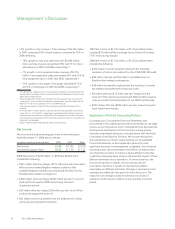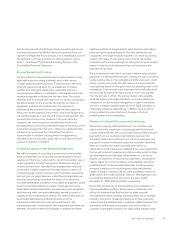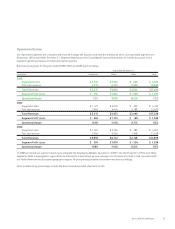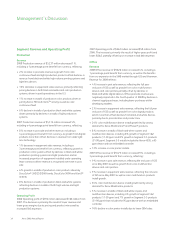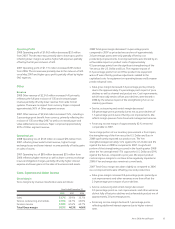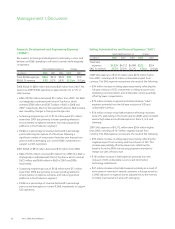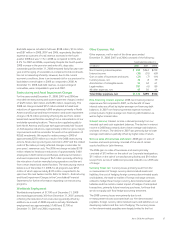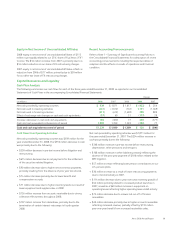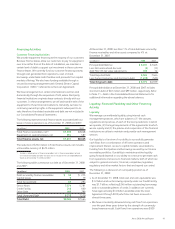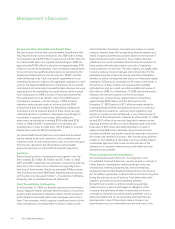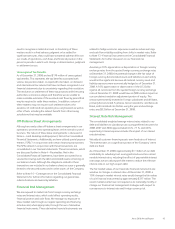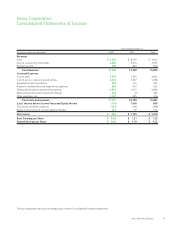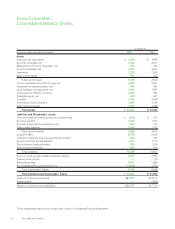Xerox 2008 Annual Report Download - page 40
Download and view the complete annual report
Please find page 40 of the 2008 Xerox annual report below. You can navigate through the pages in the report by either clicking on the pages listed below, or by using the keyword search tool below to find specific information within the annual report.
Management’s Discussion
quarter 2008 as a result of the significant and rapid weakening of
the U.S. Dollar and Euro versus the Yen.
The 2006 currency losses primarily reflected the mark-to-market of
derivative contracts which are economically hedging anticipated
foreign currency denominated payments. The mark-to-market
losses were primarily due to the strengthening of the Euro against
other currencies, in particular the Canadian Dollar, U.S. Dollar and
the Yen, as compared to the weakening Euro in 2005.
Amortization of intangible assets: 2008 amortization of
intangible assets expense of $54 million reflects amortization
expense of $33 million for intangible assets acquired as part of our
recent acquisitions.
2007 amortization of intangible assets expense of $42 million
reflects amortization expense of $16 million associated with
intangible assets acquired as part of our acquisition of GIS,
partially offset by reduced amortization from prior years due to the
full amortization of certain intangible assets from previous
acquisitions.
Legal matters: In 2008 legal matters consisted of the following:
• $721 million reflecting provisions for the $670 million court
approved settlement of Carlson v. Xerox Corporation (“Carlson”)
and other pending securities-related cases, net of expected
insurance recoveries. On January 14, 2009, the United States
Court for the District of Connecticut entered a Final Order and
Judgment approving the settlement in the Carlson litigation.
• $36 million for probable losses on Brazilian labor-related
contingencies. Following an assessment of the most recent trend
in the outcomes of these matters, we reassessed the probable
estimated loss and, as a result, recorded an additional reserve of
$36 million in the fourth quarter of 2008.
• $24 million associated with probable losses from various other
legal matters.
In 2006 legal matters consisted of the following:
• $68 million for probable losses on Brazilian labor-related
contingencies.
• $33 million associated with probable losses from various legal
matters partially offset by $12 million of proceeds from the
Palm litigation matter.
Refer to Note 16 – Contingencies in the Consolidated Financial
Statements for additional information regarding litigation against
the Company.
Income Taxes
Year Ended December 31,
(in millions) 2008 2007 2006
Pre-tax (loss) income $(114) $1,438 $ 808
Income tax (benefits) expenses (231) 400 (288)
Effective tax rate 202.6% 27.8% (35.6)%
The 2008 effective tax rate of 202.6% reflected the tax benefits
from certain discrete items including the net provision for litigation
matters; the second, third and fourth quarter restructuring and
asset impairment charges; the product line equipment write-off;
and the settlement of certain previously unrecognized tax benefits.
Excluding these items, the adjusted effective tax rate was 21.5%*.
The adjusted 2008 effective tax rate was lower than the U.S.
statutory tax rate primarily reflecting the benefit to taxes from the
geographical mix of income before taxes and the related effective
tax rates in those jurisdictions, the utilization of foreign tax credits
and tax law changes.
The 2007 effective tax rate of 27.8% was lower than the U.S.
statutory rate primarily reflecting tax benefits from the
geographical mix of income before taxes and the related effective
tax rates in those jurisdictions and the utilization of foreign tax
credits as well as the resolution of other tax matters. These
benefits were partially offset by changes in tax law.
The 2006 effective tax rate of (35.6%) was lower than the U.S.
statutory rate primarily due to the tax benefits of $518 million
from the resolution of tax issues associated with the 1999-2003
IRS audits and other domestic and foreign tax audits; tax benefits
of $19 million as a result of tax law changes and tax treaty
changes; and $11 million from the reversal of a valuation
allowance on deferred tax assets associated with foreign net
operating loss carryforwards, as well as the geographical mix of
income before taxes and related effective tax rates in those
jurisdictions. These benefits were partially offset by losses in
certain jurisdictions where we are not providing tax benefits and
continue to maintain deferred tax valuation allowances.
Our effective tax rate will change based on nonrecurring events as
well as recurring factors including the geographical mix of income
before taxes and the related effective tax rates in those
jurisdictions and available foreign tax credits. In addition, our
effective tax rate will change based on discrete or other
nonrecurring events (such as audit settlements) that may not be
predictable. We anticipate that our effective tax rate for 2009 will
approximate 28%, excluding the effect of any discrete items.
* See the “Non-GAAP Measures” section for additional information.
38 Xerox 2008 Annual Report
• $330 million decrease in pre-tax income before litigation and
• $615 million decrease due to net payments for the settlement
• $90 million decrease due to higher net income tax payments,
• $74 million decrease primarily due to lower benefit and
• $71 million decrease due to higher inventory levels as a result of
• $136 million increase from accounts receivable due to strong
• $107 million increase from derivatives, primarily due to the
• $348 million increase in pre-tax income before restructuring,
• $108 million increase in other liabilities primarily reflecting the
• $57 million increase reflecting lower pension contributions to our
• $30 million increase as a result of lower restructuring payments
• $114 million decrease due to year-over-year inventory growth of
• $73 million decrease due to a lower net run-off of finance
• $49 million decrease primarily due to higher accounts receivable


